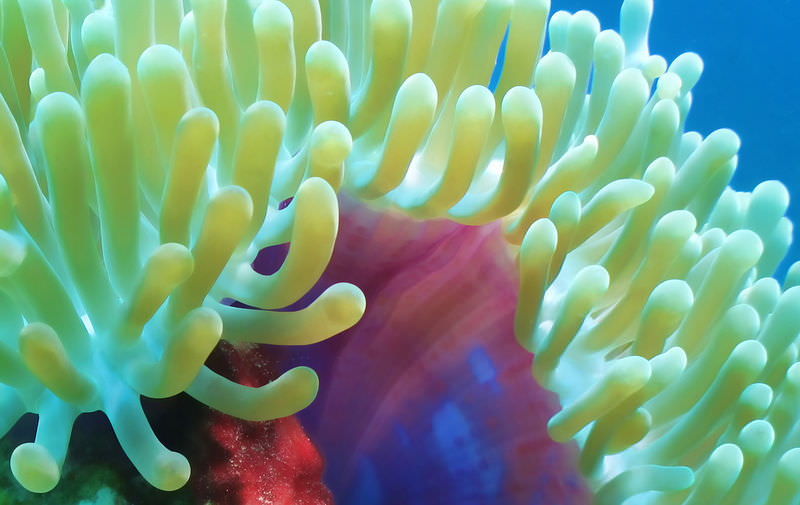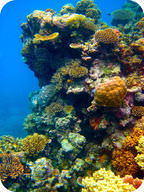11.5 日语
章节大纲
-
The sea anemone. Plant or animal?
::海葵,植物还是动物?It may look like a plant, but it's not. Sea anemones are a group of water-dwelling, predatory in the phylum Cnidaria . A sea anemone is a polyp attached at the bottom to the surface beneath it. They can have anywhere from a few tens of tentacles to a few hundred tentacles. And they eat small and shrimp.
::它可能看起来像植物,但它不是。海葵是一群水栖息的动物。海葵是植物下层的聚虫。海葵可以有几十个触手和几百个触手。它们吃小虾和小虾。Cnidarians
::捷克人Cnidarians are invertebrates such as jellyfish and corals. They belong to the phylum Cnidaria. All cnidarians are . Most of them live in the ocean. Cnidarians are a little more complex than . They have radial symmetry and tissues . There are more than 10,000 cnidarian . They are very diverse, as shown in Figure .
::Cnidarians是水母和珊瑚等无脊椎动物,它们属于Cnidaria植物。所有的cnidarians都生活在海洋中。他们大多数生活在海洋中。Cnidarians比(......)要复杂一些。他们有辐射对称和组织。有超过10,000个cnidarian。它们非常多样化,如图所示。Cnidarian Diversity. Cnidarians show a lot of variability.
::尼达人的多样性 尼达人表现出很多变异性Structure and Function of Cnidarians
::辛语人的结构和职能All cnidarians have something in common. It’s a nematocyst , like the one shown in Figure . A nematocyst is a long, thin, coiled stinger. It has a barb that may inject poison. These tiny poison "darts" are propelled out of special . They are used to attack prey or defend against predators .
::所有的辛达里人都有共同点。 就像图中显示的那样,它是一个神经囊肿。 神经囊肿是一个长的、薄的、缠绕的刺刺。 它有一个可能注入毒药的巴布。 这些微小的毒药“飞镖”是特别的。 它们被用来攻击猎物或防御捕食者。Cnidarian Nematocyst. A cnidarian nematocyst is like a poison dart. It is ejected from a specialized cell.
::尼玛托西斯特 尼玛托西斯特 尼玛托西斯特 尼玛托西斯特就像毒镖There are two basic body plans in cnidarians. They are called the polyp and medusa . Both are shown in Figure . The polyp has a tubular body and is usually sessile . The medusa (plural, medusae ) has a bell-shaped body and is typically motile. Some cnidarian species alternate between polyp and medusa forms. Other species exist in just one form or the other.
::辛尼达里亚人有两种基本身体图案,称为聚虫体和甲草胺。两种图示都显示于图中。聚虫体有一个管状体,通常为悬浮体。甲草胺(多元体、甲草胺)有一个钟形体,一般为运动体。一些昆虫种在聚虫体和甲草胺形态之间交替。其他物种只以一种或另一种形式存在。Cnidarian Body Plans. Cnidarians may exist in the polyp (left) or medusa (right) form.
::纳粹身体计划。 纳粹可能存在于聚苯乙烯( 左) 或地中海( 右) 形式中。The body of a cnidarian consists of two cell layers, ectoderm and endoderm . The cells surround a digestive cavity called the coelenteron (see Figure ). Cnidarians have a simple . The single opening is surrounded by tentacles, which are used to capture prey. The tentacles are covered with nematocyst cells. Digestion takes place in the coelenteron. Nutrients are absorbed and gases exchanged through the cells lining this cavity. Fluid in the coelenteron creates a hydrostatic skeleton .
::内分泌体由两层细胞组成, 乳腺和内分泌物。 细胞环绕着一个叫做内分泌物的消化腔( 见图 ) 。 内分泌物有一个简单 。 单开口被用来捕捉猎物的触角包围。 触角被内分泌细胞覆盖。 内分泌物在内分泌物中发生。 内分泌物被吸收,气体通过内分泌细胞交换。 内分泌物在内分泌物中产生一个流体骨骼。Cnidarians have a simple consisting of a nerve net that can detect touch. They may also have other sensory structures. For example, jellyfish have light-sensing structures and gravity-sensing structures. These give them a sense of up versus down. It also helps them balance .
::克尼达里亚人有一个简单的神经网组成,可以探测触摸。他们也可能有其他感官结构。例如,水母有轻感应结构和重力感应结构。这些结构能让他们感觉上下对上,也能帮助他们平衡。Cnidarian Reproduction
::基督教生殖Figure shows a general cnidarian . Polyps usually reproduce asexually. One type of in polyps leads to the formation of new medusae. Medusae usually reproduce sexually. forms a zygote . The zygote develops into a larva called a planula . The planula, in turn, develops into a polyp. There are many variations on the general life cycle. Obviously, species that exist only as polyps or medusae have a life cycle without the other form.
::图中显示了一般的cnidarian. polyps 通常会发生性繁殖。在聚虫中,有一种类型导致形成新的 medusae 。 Medusae 通常会发生性繁殖。 形成一个 zygote 。 zygote 会发展成一个叫Planula 的幼虫。 反过来又会发展成一个聚虫。 一般生命周期存在许多变化。 显然, 仅作为聚虫或 medusae 存在的物种的生命周期没有另一种形式。General Cnidarian Life Cycle. Cnidarians may reproduce both asexually and sexually.
::普通的克尼达尔人生命周期 克尼达尔人可以性欲和性欲同时繁殖Ecology of Cnidarians
::辛迪里亚人生态学Cnidarians can be found in almost all ocean habitats . They may live in that is shallow or deep, warm or cold. A few species live in freshwater. Some cnidarians live alone, while others live in colonies.
::几乎在所有的海洋生境中都可以找到辛达里人,他们可能生活在浅水或深水、温暖或寒冷的海洋中,少数物种生活在淡水中,一些辛达里人独自生活,而另一些则生活在殖民地中。Corals form large colonies in shallow water. They are confined to shallow water because they have a mutualistic relationship with that live inside them. The algae need sunlight for , so they must be relatively close to the surface of the water. Corals exist only as polyps. They catch plankton with their tentacles. Many secrete a calcium carbonate exoskeleton . Over time, this builds up to become a coral reef (see Figure ). Coral reefs provide food and shelter to many ocean organisms . They also help protect shorelines from erosion by absorbing some of the energy of waves. Coral reefs are at risk of destruction today.
::珊瑚在浅水中形成大型聚居地。 它们被限制在浅水中, 因为它们与生活在浅水中的生物有相互的关系。 藻类需要阳光, 因此它们必须相对接近水面。 珊瑚只作为聚虫存在。 它们用触角捕捉浮游生物。 许多碳酸钙的外骨骼秘密。 随着时间的推移, 珊瑚礁逐渐形成珊瑚礁(见图 ) 。 珊瑚礁为许多海洋生物提供了食物和栖息地。 它们也通过吸收一些波浪的能量来帮助保护海岸线不受侵蚀。 珊瑚礁今天面临毁灭的危险。Great Barrier Reef. The Great Barrier Reef is a coral reef off the coast of Australia.
::大堡礁 大堡礁是澳大利亚沿海的珊瑚礁Unlike corals, jellyfish spend most of their lives as medusae. They live virtually everywhere in the ocean. They are typically carnivores . They prey on zooplankton , other invertebrates, and the eggs and larvae of fish.
::与珊瑚不同的是,水母的一生大部分时间都是作为食宿的。它们几乎生活在海洋的任何地方。它们通常是食肉动物。它们食用浮游动物、其他无脊椎动物、鱼卵和幼虫。KQED: Amazing Jellies
::KQED:惊人的果冻Jellyfish. They are otherworldly creatures that glow in the dark, without brains or , some more than 100 feet long. And there are many different types. Jellyfish are free-swimming members of the phylum Cnidaria. Jellyfish are found in every ocean, from the surface to the deep sea.
::Jellyfish。它们是其他世界性生物,在黑暗中发光,没有大脑,或超过100英尺长。有多种种类。Jellyfish是植物圈中自由游动的成员。从海面到深海,在所有海洋中都发现了Jellyfish。Summary
::摘要-
Cnidarians include jellyfish and corals.
::辛达里亚人包括水母和珊瑚。 -
Cnidarians are aquatic invertebrates. They have tissues and radial symmetry. They also have tentacles with stingers.
::Cnidarians是水生无脊椎动物,它们有组织,有辐射对称,还有带有刺刺的触手。 -
There are two cnidarian body plans: the polyp and the medusa. They differ in several ways.
::有两种共生体计划:聚氨酯和甲草胺。它们在许多方面不同。 -
Many corals secrete an exoskeleton that builds up to become a coral reef.
::许多珊瑚都分泌出一个外骨骼 形成成为珊瑚礁的外骨骼
Review
::回顾-
What is a nematocyst? What is its function?
::什么是神经细胞?它的作用是什么? -
How do coral reefs form?
::珊瑚礁如何形成? -
Compare and contrast cnidarian polyps and medusae.
::比较和对比 尼氏多胞胎和医卫。
-
Cnidarians include jellyfish and corals.





